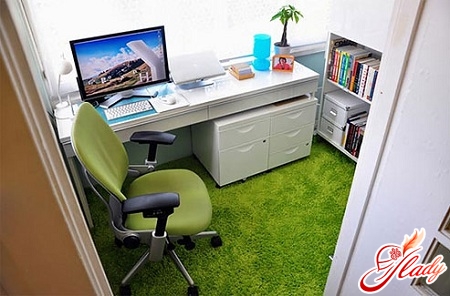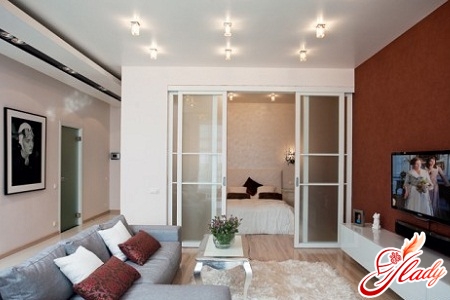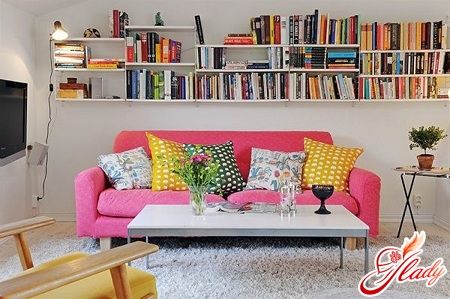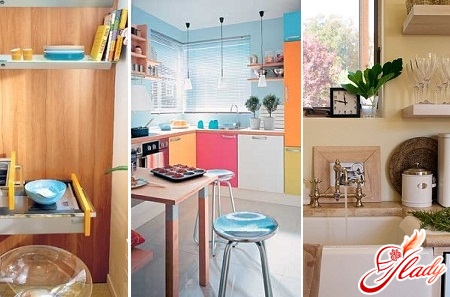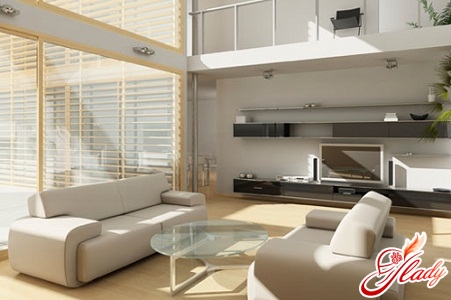 The real brainchild of the industrial age is styleloft. This is an attic style that turns a non-residential space into a quite tolerable dwelling. Not only is it tolerable, but it is also fashionable now. Probably, the loft style in the interior is just the latest fashion. True, in Russian interior design this style is not yet presented in its pure form, but it is already actively used in the design of elite housing. In the West, loft-style apartments have become a common phenomenon for a long time, so the rapid entry of this style into our mass housing is quite predictable. This is especially true for megacities and large industrial cities, since loft is an exclusively urban product. What is hidden behind such an unfamiliar concept for us? What is its peculiarity? Let's figure it out.
The real brainchild of the industrial age is styleloft. This is an attic style that turns a non-residential space into a quite tolerable dwelling. Not only is it tolerable, but it is also fashionable now. Probably, the loft style in the interior is just the latest fashion. True, in Russian interior design this style is not yet presented in its pure form, but it is already actively used in the design of elite housing. In the West, loft-style apartments have become a common phenomenon for a long time, so the rapid entry of this style into our mass housing is quite predictable. This is especially true for megacities and large industrial cities, since loft is an exclusively urban product. What is hidden behind such an unfamiliar concept for us? What is its peculiarity? Let's figure it out.
The appearance of the loft style
The meaning of the English word "loft" isattic, a room on the top floor, the top floor itself. This word has only recently been used to describe a new interior style, although the style itself originated in the first half of the twentieth century in New York, in the industrial district of Manhattan. It was there, in the forties of the last century, that cheap premises of old industrial buildings were first used for housing and offices. How did this happen? It's very simple. As a result of the rapid rise in the cost of land in the city center, industrialists were forced to relocate to its outskirts, and young and poor representatives of creative professions began to occupy the vacated factory buildings. It was very profitable for artists and musicians to arrange spacious premises with high ceilings and good lighting for housing, not only because of the affordable price. It was also a convenient and profitable solution for combining living and working space, an apartment and an art workshop (studio). At the same time, such elements as untreated brick walls, beams, pipes and other signs of the industrial purpose of the premises were left untouched, which did not bother the inhabitants of these premises and gave a certain originality to the interior. It was this originality that the famous architect and designer Andy Warhol began to develop as a stylistic direction, and after him, other masters of interior design in America and Europe. In just ten years, original loft-style housing began to be considered exclusively elite and was no longer affordable for poor artists and musicians.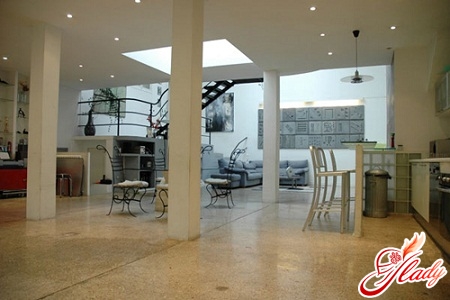
Loft style concept
Despite the fact that the new style is called"Attic", loft creates a new concept of organizing interior space. In a loft interior, isolated rooms are practically absent, all separate "rooms" are conditionally divided functional zones. The concept of the loft style is based on this special open layout. Partitions are practically absent (with the exception of the bathroom, toilet and utility rooms), and the zoning of the room is carried out using the texture and color of the finishing materials of the walls, ceiling and floor. For example, the living room has brick walls, and the bedroom following it is finished with plaster, in turn, a ceiling beam or a bar counter can mark the border of the kitchen. In addition to this method of zoning, loft interiors also use the division of "rooms" with mobile partitions - screens and shelves, furniture.
Loft style features
Loft interior is, first of all, a lotair and light. Therefore, the key spatial and design characteristics of the loft style emphasize the volume and “infinity” of the living space. The main features that form the space of this style:
- openness (absence of bearing partitions);
- high ceilings (sometimes higher than ten meters);
- a large area (from hundreds to thousands of square meters);
- wide windows (sometimes the whole wall).
The design features of the loft style are akin tocharacteristics of minimalism: minimum furniture and minimum decor with maximum open space. Unlike minimalism, which strives for functional and comfortable simplicity, loft is distinguished by its elegant and even refined simplicity. This is facilitated not only by the minimum amount of furniture, but also by focusing attention on it. The entire interior space should simply be a modest background for loft-style furniture. For example, there can be only one sofa in such a room (with its immense size). But at the same time, it must attract attention due to its brightness or unusual shape. Windows that overlook the urban landscape must be floor-length. There should be no curtains on them that prevent the penetration of light, or even light and transparent curtains and tulle. Windows in a loft interior are decorated only with blinds (vertical or horizontal). The texture of the finish for a loft-style interior is This is a combination of ultra-modern materials (glass and steel) with a decidedly unmodern and seemingly unfinished finish (bare brick, uneven plaster, rough boards and beams). Smooth painted or brick walls, plank floors and ceiling beams will set the right tone for the union of exquisite modern (or vintage) furniture with unpretentiousness and deliberate roughness of the finish. After all, it is the juxtaposition of old and new and the maximum sense of space - these are the main features of a loft interior.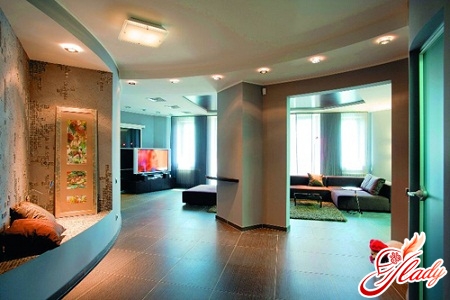
Furniture and accessories
Features of interior furniture in loft styleare determined by the main stylistic concept (minimalist sophistication). Therefore, the furniture should emphasize the openness of the interior space and at the same time be an accent. Surprisingly, the furniture of the loft interior should be noticeable and bright at the same time and, at the same time, seem to dissolve in space. How do designers achieve such a contradictory effect? Firstly, the furniture of the loft interior is never tied to the walls and thus does not emphasize the boundaries of the room. An exception in this case may be open shelves or racks near one of the walls. All other furniture is transformers and easily movable individual items. For example, armchairs and a hanger on wheels, folding chairs and tables, long sofas bending in different directions. An indispensable element of fashionable or antique furniture for this style is metal elements of the structure or decoration (or even the material itself). These are chromed frames for racks, metal legs for beds and sofas, cast iron bathtubs, metal hangers. At the same time, furniture for a loft apartment can combine materials that seem incompatible at first glance - plastic and natural wood, stainless steel and fur, expensive exquisite fabrics and synthetics. The color of the furniture is always bright and eye-catching, but only one. The shapes are unusual and varied, from rigid cubic to curved and smooth rococo shapes. The unity of style is emphasized by the use of furniture with the same design elements. All this allows you to make the loft-style interior unusual, stylistically consistent and unique. The uniqueness of the loft interior is also facilitated by original accessories. There are no usual wall panels, paintings in expensive or sentimental frames, family photo galleries. Accessories for the loft interior are very original. They are what usually surrounds any resident of a large industrial city - advertising posters, road signs, graffiti or signboards. Of course, you can use familiar decorative elements, but they should be as close as possible to the general urban concept and not violate the style of the room. If these are paintings, then abstract, if photographs, then black and white with urban or industrial landscapes, if floor vases, then massive. Paintings, for example, can be located directly on the floor, remaining only leaning against the wall. Soft poufs, unusual trinkets and other accessories that emphasize the profession or hobbies of the owner can also enliven the loft-style interior and give it the appropriate atmosphere.
Addressing the style of the loft
And now about the most important thing:for whom this new urban style is suitable, and for whom it is directly contraindicated. It is clear that you always want to follow fashion, including perhaps interior design. However, the loft style is not suitable for everyone. You can understand this by agreeing with some statements or, on the contrary, refuting them. So, the loft style is simply ideal for those who:
- prefers the free planning of their housing;
- adheres to the tendencies of minimalism in interior design;
- welcomes in his house an abundance of light, air and free space;
- likes furniture and household appliances of clear and concise forms;
- adores order in the house and orderliness of living space;
- lives in a modern house or apartment with a very large area, high ceilings and huge windows.
The loft style is definitely not suitable for those who:
- wants to have his own, separate room in which you can retire and have a rest;
- does not like excess free space in the house;
- prefers cozy and very "home" styles of the interior;
- likes to cook and spends a lot of time in the kitchen;
- wants to live in a multi-room apartment or house;
- adores interior decoration, prone to sentimentality;
- has a large family that lives in the same house.
From this we can conclude that the loft interior,which is characterized by spaciousness and the absence of secluded corners, suits mainly creative people and those who are not burdened with household chores. Why? Because the features of the loft style provide unlimited space for self-expression and creative experiments. Today, this New York style is preferred by wealthy individualists, artists, painters, people of public professions, and recently by many young couples. Perhaps because a loft is not only a special home, but rather a lifestyle.





